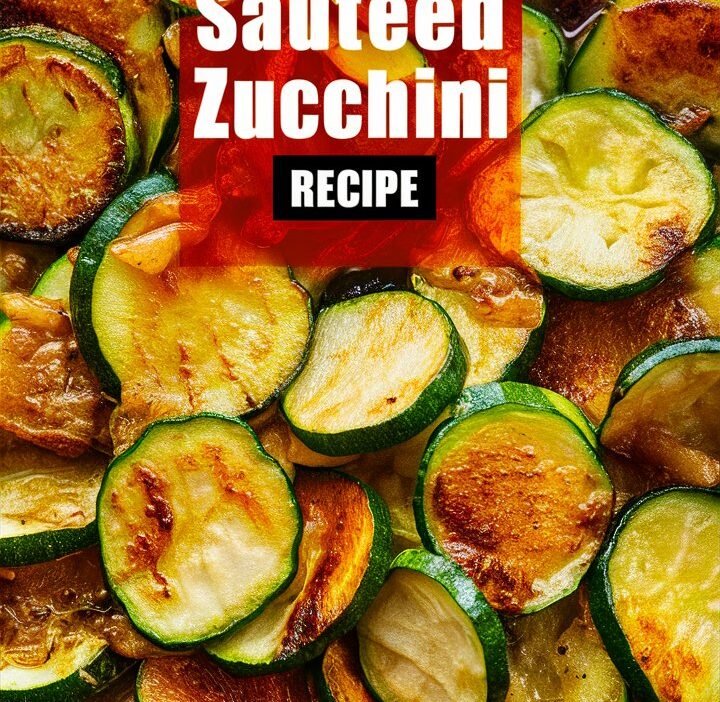Some dishes remind us that culinary perfection doesn’t always require complexity. Sautéed zucchini is one of those rare creations that celebrates simplicity, freshness, and flavor all in one bite. Imagine tender slices of zucchini glistening in golden olive oil, kissed with the aroma of fresh garlic and sprinkled with herbs. Each piece delivers a delightful balance — soft inside, lightly crisp on the outside, and bursting with subtle sweetness.
This humble yet versatile dish captures the very essence of good home cooking: minimal ingredients, quick preparation, and maximum satisfaction. Whether you serve it as a side dish, fold it into pasta, or enjoy it with crusty bread, sautéed zucchini adds warmth and color to every meal.
In this complete guide, you’ll learn not only how to make perfect sautéed zucchini but also why each step matters — from choosing the right zucchini to mastering the ideal cooking time. By the end, you’ll be able to cook it confidently, creatively, and deliciously every single time.
Why You’ll Love This Sautéed Zucchini Recipe
There’s something magical about a recipe that’s as simple as it is impressive. Here’s why this dish will easily become one of your favorites:
- Quick and Effortless:
It takes less than 20 minutes from start to finish. Perfect for busy weeknights or spontaneous family dinners. - Healthy Yet Satisfying:
Zucchini is naturally low in calories and high in fiber, vitamins, and minerals. A guilt-free side that nourishes your body. - Versatile and Customizable:
You can pair it with almost anything — rice, pasta, fish, or chicken. You can even add cheese, spices, or other veggies. - Budget-Friendly:
Simple ingredients — zucchini, olive oil, garlic, and herbs — all affordable and readily available year-round. - Perfect for Any Occasion:
It’s elegant enough for a dinner party yet comforting enough for a solo meal after work.
Understanding Zucchini – The Star Ingredient
Before cooking, it helps to understand what makes zucchini such a special vegetable. Also known as courgette in some parts of the world, zucchini belongs to the summer squash family. It’s rich in water and fiber, making it light, hydrating, and easy to digest.
Nutritional Benefits
- Low in Calories: One cup of sliced zucchini contains roughly 20–25 calories.
- Rich in Vitamins: Especially vitamin C, vitamin A, and B6, which support skin health and immunity.
- High in Antioxidants: The skin contains carotenoids like lutein and zeaxanthin that promote eye health.
- Good Source of Fiber: Supports digestion and helps maintain stable blood sugar levels.
- Hydrating: Composed of about 95% water, making it refreshing and perfect for summer meals.
Selecting the Best Zucchini
For the most flavorful sautéed zucchini, quality starts at the market.
Look for:
- Firm, glossy skin without wrinkles or soft spots.
- A medium size (6–7 inches long). Smaller zucchinis are sweeter and less watery.
- A fresh, green stem — a sign that it was recently harvested.
Avoid oversized zucchinis; they tend to have large seeds and a more fibrous texture.
Ingredients You’ll Need
Here’s what you’ll need for a basic sautéed zucchini dish that serves four people:
- 4 medium fresh zucchinis
- 2–3 tablespoons extra virgin olive oil
- 2–3 garlic cloves, minced
- Salt and freshly ground black pepper (to taste)
- Fresh herbs such as basil, parsley, or thyme
- (Optional): A pinch of red chili flakes, lemon zest, or grated Parmesan for extra flavor
Pro Tip: Use high-quality olive oil — its fruity aroma perfectly complements the zucchini’s mild sweetness.
Step-by-Step Instructions for Perfect Sautéed Zucchini
Step 1: Prep the Zucchini
Rinse the zucchini under cool running water and pat dry. Slice off both ends. Cut each zucchini into half-moons about ½ inch thick. This shape ensures even cooking and an appealing presentation.
If you prefer a different look, you can also slice zucchini into thin rounds or matchstick strips — just adjust the cooking time slightly.
Step 2: Heat the Pan
Choose a large skillet (10–12 inches) to prevent overcrowding. Add two tablespoons of olive oil and heat it over medium-high heat. The oil should shimmer but not smoke — that’s the ideal temperature for sautéing.
Cooking Insight: Overcrowding the pan traps steam, turning your vegetables mushy instead of crisp. Cook in batches if necessary.
Step 3: Add Garlic
When the oil is ready, add minced garlic. Sauté for about 30–60 seconds until fragrant. Be careful not to brown or burn the garlic — it should release aroma without turning bitter.
Step 4: Cook the Zucchini
Add the sliced zucchini to the skillet. Stir occasionally to ensure even cooking. Let it cook for about 5–7 minutes until the pieces are tender but still slightly firm. You’re aiming for a texture that’s juicy inside with a gentle sear on the outside.
Season with salt and pepper while cooking. Taste and adjust as needed.
Step 5: Add Herbs and Finishing Touches
In the final minute, stir in your chopped herbs. Basil adds a sweet fragrance, parsley gives freshness, and thyme contributes an earthy tone.
You can also experiment — sprinkle lemon zest for brightness, add chili flakes for spice, or toss in Parmesan for a creamy touch.
Step 6: Serve and Enjoy
Serve immediately while hot. Sautéed zucchini tastes best when fresh, as its texture and flavor peak right after cooking.
Enjoy it as:
- A side dish to grilled chicken or fish
- A topping for pasta or risotto
- A filling for sandwiches and wraps
- A healthy addition to omelets or scrambled eggs
Tips and Tricks for the Best Results
- Cut Evenly for Consistency:
Uniform slices cook evenly and look beautiful on the plate. - Control Heat:
Medium-high heat allows the zucchini to sear quickly without becoming soggy. - Don’t Overcrowd the Pan:
Give each piece space to brown — sauté in batches if you must. - Season Gradually:
Add a small amount of salt at the beginning, then adjust toward the end to balance moisture. - Enhance with Finishing Oil:
Drizzle a touch of raw olive oil just before serving for a glossy finish and richer taste. - Add Texture:
Toasted pine nuts, sesame seeds, or sunflower seeds can add crunch and nutrition. - Experiment with Flavors:
Try Mediterranean spices like oregano or North African flavors with cumin and paprika.
Serving Ideas and Pairings
Sautéed zucchini’s mild, buttery flavor makes it incredibly adaptable. Here are some inspired ways to serve it:
1. With Grains
Pair it with rice, couscous, or quinoa for a hearty vegetarian meal. The zucchini’s lightness complements the grains’ density perfectly.
2. With Pasta
Toss sautéed zucchini with spaghetti, olive oil, and a sprinkle of Parmesan for a simple Italian-style dish.
3. With Protein
Serve it alongside grilled salmon, roasted chicken, or seared tofu. Its subtle sweetness balances savory mains beautifully.
4. In a Wrap or Sandwich
Layer it with roasted peppers, mozzarella, and basil in a warm pita or ciabatta roll.
5. With Eggs
Use leftover sautéed zucchini in omelets, frittatas, or scrambled eggs for a nutritious breakfast.
Make-Ahead, Storage, and Reheating
Make-Ahead
You can slice and prep zucchini a day in advance. Store it in an airtight container in the fridge to maintain freshness.
Storage
Leftover sautéed zucchini keeps well for up to three days in the refrigerator. Use a sealed glass container to preserve flavor and prevent excess moisture.
Reheating
Warm leftovers gently in a skillet over medium heat for about five minutes. Avoid the microwave when possible — it can make zucchini limp.
Freezing
Although you can freeze sautéed zucchini, its texture may change. If you plan to use it in soups, stews, or casseroles later, freezing is acceptable.
Flavor Variations and Add-Ons
- Garlic Butter Zucchini:
Replace olive oil with butter for a rich, comforting flavor. - Spicy Mediterranean Style:
Add chili flakes, paprika, and a touch of lemon juice. - Cheesy Delight:
Sprinkle grated Parmesan or feta cheese just before serving. - Asian Twist:
Toss with soy sauce, sesame oil, and a dash of ginger. - Zucchini with Tomatoes and Onions:
Sauté onion first, then add zucchini and cherry tomatoes for a colorful summer medley.
Common Mistakes to Avoid
- Overcooking: Makes zucchini mushy. Watch the color and texture closely.
- High Salt Early: Draws out moisture and prevents browning.
- Crowded Pan: Steams instead of sears.
- Old Zucchini: Lacks sweetness and texture. Always pick fresh produce.
Nutritional Information (per 1-cup serving)
- Calories: ~55
- Carbohydrates: 9 g
- Fiber: 2 g
- Protein: 2 g
- Fat: 4 g (mostly healthy unsaturated fats)
- Sodium: 10 mg
- Sugar: 3 g
- Cholesterol: 0 mg
Health Note: This recipe fits vegetarian, gluten-free, and low-carb diets.
Frequently Asked Questions (FAQs)
1. How can I make zucchini less watery?
Pat slices dry with a towel before cooking. Cooking over medium-high heat also helps evaporate moisture quickly.
2. Can I use frozen zucchini?
Fresh is best, but if using frozen, thaw and drain thoroughly to remove excess water before sautéing.
3. What herbs work best?
Fresh basil, parsley, thyme, or dill pair wonderfully with zucchini’s mild flavor.
4. Can I cook zucchini without oil?
Yes. You can use a non-stick pan and a splash of vegetable broth for a lighter version.
5. How do I get more flavor?
Use good olive oil, fresh garlic, and finish with a squeeze of lemon juice or a sprinkle of sea salt.
6. Can sautéed zucchini be made vegan or keto?
Absolutely. The base recipe is naturally vegan and low in carbohydrates.
The Culinary Science Behind Sautéing
Sautéing is more than just frying — it’s a precise cooking technique. The word comes from the French sauter, meaning “to jump,” referring to how ingredients move in the pan.
When done right, sautéing caramelizes natural sugars in vegetables, unlocking depth and aroma. For zucchini, this technique enhances sweetness while maintaining structure — the golden edge you see is the Maillard reaction, responsible for that mouth-watering flavor.
Understanding this helps you adjust heat, timing, and stirring to achieve professional-level results.
Creative Ways to Use Leftover Sautéed Zucchini
- Mix into pasta salad for extra texture and color.
- Layer in lasagna as a low-carb replacement for noodles.
- Blend into soup for a creamy vegetable base.
- Add to tacos for a fresh, plant-based filling.
- Top pizza for a healthier, homemade option.
Conclusion – Mastering the Art of Simplicity
Sautéed zucchini proves that culinary excellence doesn’t require elaborate techniques or exotic ingredients. It’s a celebration of nature’s simplicity — where freshness, timing, and care transform an everyday vegetable into something extraordinary.
With just a handful of ingredients and a few mindful steps, you can create a dish that’s healthy, vibrant, and comforting. It’s the kind of food that reminds us why cooking matters: it nourishes, connects, and inspires.
So next time you’re short on time but craving something wholesome, reach for a few fresh zucchinis, a clove of garlic, and a drizzle of olive oil. In less than 20 minutes, you’ll have a dish that not only feeds your body but also lifts your spirit — the true mark of perfect home cooking.




